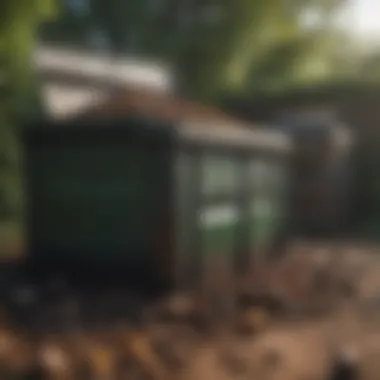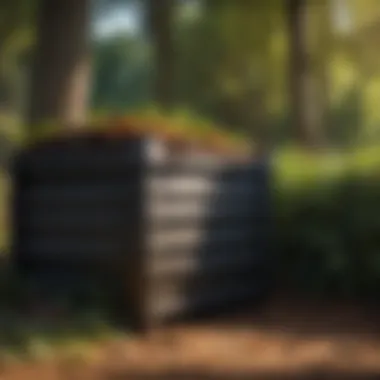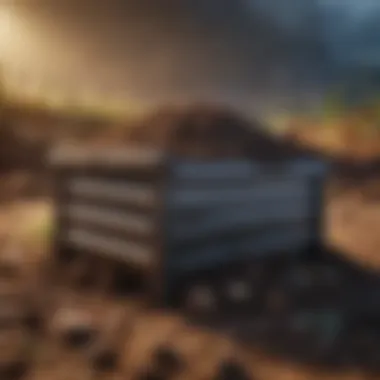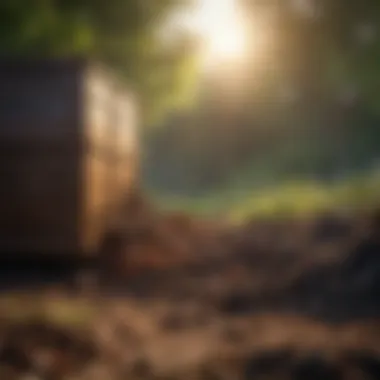A Comprehensive Guide to Buying a Compost Bin


Intro
Composting is a significant practice in waste management and sustainable agriculture. Choosing the right compost bin is essential for effective composting. Many factors influence this decision, including the type of composting method, space availability, and personal preferences. In this guide, we will explore the different types of compost bins, maintenance tips, and alternative options. Understanding these aspects can lead to better waste reduction and environmental sustainability.
Topic Overview
Definition and Importance
A compost bin is a container designed to collect organic waste and facilitate the composting process. Composting transforms kitchen scraps and yard waste into nutrient-rich soil additive. This process not only reduces landfill waste but also enriches soil health, benefiting plants and improving yields.
The importance of selecting the right compost bin cannot be overlooked. Different bins cater to various needs, from small apartments to larger gardens. Each type has its advantages and limitations, which must be considered when making a purchase.
Brief History and Evolution
Composting has a long history dating back to ancient civilizations. Early farmers recognized the value of decomposed materials in enriching soil. Over time, methods and materials evolved. Today, modern compost bins come in various styles, including tumblers, stationary bins, and worm composters. This evolution reflects growing awareness of environmental issues and sustainable practices.
Key Factors in Choosing a Compost Bin
Types of Compost Bins
Choosing a type of compost bin is essential. Common options include:
- Traditional bins: These are often made of wood or plastic and allow for passive composting.
- Tumbler bins: They are enclosed and can be turned easily for aeration.
- Worm bins: Also known as vermicomposting, using worms for decomposition.
Space Considerations
Space is a determining factor in selecting a compost bin. Individuals with small yards or apartments may prefer compact designs. Those with ample space might opt for larger stationary bins. Understanding the available area helps narrow down options effectively.
Budget
Budget constraints also affect choices. Compost bins range from inexpensive DIY options to premium models. Defining a budget ahead of time can streamline the buying process.
Practical Applications
Step-by-Step Guide to Buying a Compost Bin
- Assess your needs: Consider the amount of organic waste generated.
- Select the type: Reflect on the types listed above to find what suits your lifestyle.
- Evaluate space: Measure the area where the bin will be placed.
- Set a budget: Determine how much you are willing to spend.
- Research options: Look for reviews and recommendations on specific models.
- Purchase: Choose a reliable place to buy the compost bin.
Maintenance Tips
Proper maintenance is key to successful composting. Regularly turning the pile ensures aeration, which aids decomposition. Monitoring moisture levels also is vital; the compost should have a similar consistency to a damp sponge. Checking for pests and maintaining an appropriate carbon-to-nitrogen ratio will optimize the process.
"Regular maintenance of your compost bin not only enhances the efficiency but also ensures a healthier end product."
Closure
Buying a compost bin involves careful consideration of various factors. Understanding your needs, space, and budget is crucial. With the right bin, composting can be a rewarding experience that contributes to sustainability and improves garden health.
Foreword to Composting
Composting represents a crucial practice for those aiming to minimize waste and enrich soil health. It converts organic materials into nutrient-rich compost, working as a natural fertilizer. Understanding the principles of composting is essential in the broader context of sustainable living. In this section, we will delve into what composting is, its significance, and how it can contribute to a more sustainable environment.
What is Composting?
Composting is the process of breaking down organic matter, such as food scraps and yard waste, into a usable substance known as compost. This transformation occurs through the action of microorganisms, worms, and other decomposers that thrive in a controlled environment. During composting, organic materials undergo a series of biological changes that reduce their volume, creating a dark, crumbly product that can be used to enhance soil fertility.
Benefits of Composting
The benefits of composting extend beyond mere convenience. By converting waste into compost, you effectively:
- Reduce landfill burden, thus minimizing environmental impact.
- Decrease greenhouse gas emissions associated with waste decomposition in landfills.
- Produce high-quality compost that improves soil structure, enhances moisture retention, and nourishes plants without the need for chemical fertilizers.
- Contribute to a circular economy by returning nutrients back to the soil.


Composting is not just a hobby; it is a vital step towards more sustainable agricultural practices and environmental stewardship.
The process of composting represents a commitment to crafting a healthier planet. As we advance in this article, we will explore how selecting the right compost bin is integral to effective composting.
Understanding Compost Bins
Understanding compost bins is crucial for anyone looking to engage in composting effectively. A compost bin serves as a controlled environment where organic waste can decompose and transform into nutrient-rich compost. This process not only reduces waste but also contributes to sustainable farming practices and gardening. Each type of compost bin offers unique advantages and limitations. Therefore, understanding these options enables individuals to select a bin that aligns with their composting goals and lifestyle.
Types of Compost Bins
Cold Compost Bins
Cold compost bins are an excellent choice for those who prefer a slower decomposition process. This method relies on natural breakdown of materials, which means you add organic waste without the need for turning or maintaining high temperatures. The key characteristic of cold compost bins is their simplicity. They require minimal effort, making them favorable among beginners, or people who have limited time. However, this method might take several months before producing usable compost.
The benefits of cold composting include
- Low maintenance, as no frequent monitoring is needed.
- Freedom to add materials as they become available.
- Ability to accommodate larger quantities of green waste over time.
However, it does have disadvantages, such as the prolonged wait for compost and potential odor issues if improper materials are added.
Hot Compost Bins
Hot compost bins offer a more accelerated method of composting. They reach high temperatures, which can speed up the breakdown of organic materials. The primary feature of hot compost bins is their efficiency, often producing usable compost within weeks. For individuals who desire quicker results, hot composting is a beneficial choice. The combination of heat and regular turning promotes nutrient-rich compost, ideal for gardening and farming.
Despite the advantages, hot composting requires more commitment regarding monitoring temperatures and maintaining balance. Adequate materials and turning are necessary to keep the process effective. The unique characteristic of hot compost bins also means they can tackle a wider variety of organic matter, minimizing unpleasant odors. However, this method demands diligence.
Tumbling Composters
Tumbling composters provide a dynamic means of composting. They facilitate easier turning of materials, which helps aerate the compost and maintains optimal conditions for decomposition. The standout feature of tumbling composters is their user-friendly design. They simplify managing the composting process while promoting even mixing. This creates a more efficient composting environment compared to static bins.
Benefits include:
- Simplicity in turning, offering quicker results.
- Reduced odor and pest attraction due to sealed design.
However, tumbling composters may not accommodate larger batches effectively. The capacity can be limited compared to other types.
Worm Composters
Worm composters, or vermicomposters, utilize earthworms to break down organic matter. This process is particularly efficient for processing kitchen scraps. The key feature here is the involvement of living organisms, which produce high-quality compost known as worm castings. This is considered one of the best forms of compost for fertilizing plants.
Worm composting benefits from:
- Optimized use of kitchen waste, making it very suitable for urban settings.
- High-quality compost in a smaller space compared to traditional outdoor methods.
However, worm composters have their drawbacks. They require special care, such as choosing the right type of worms and maintaining appropriate moisture levels. Care must also be taken to ensure that materials do not overwhelm the system.
Choosing the Right Size
Selecting the appropriate size for a compost bin is vital. The size should correspond to the volume of organic waste produced by the household or garden. A small bin may not suffice for larger families or garden enthusiasts, while an overly large bin can be impractical. It is essential to consider your composting goals and available space before making a decision. To adequately balance convenience and efficiency, evaluate the frequency and amount of waste generated in order to select a bin suitable for your composting needs.
Key Factors in Selection
When considering the purchase of a compost bin, emphasizing key factors in selection is crucial. Understanding these elements can streamline your decision-making process and ensure you choose a compost bin that fits your needs effectively. Key factors to keep in mind include the materials used to make the bin, the aeration and drainage features, and the ease of access and maintenance. Each of these factors impacts the composting process and influences the quality of the compost produced.
Material Considerations
Plastic vs. Metal vs. Wood
The material of a compost bin greatly affects its performance and durability. Plastic bins are often lightweight and resistant to rust and decay, making them a convenient choice. They tend to be less expensive and easier to clean than metal or wood. However, some high-quality plastics can become brittle over time under extreme temperatures. In contrast, metal bins are incredibly durable and can withstand harsh weather conditions. They usually provide better insulation, which can enhance the composting process. One downside is they can be heavier and more difficult to manage.
Wooden bins provide a natural aesthetic and can be very effective if constructed properly. They allow for good airflow, which is beneficial for composting. Nevertheless, they can be susceptible to rot and pests if not treated properly. Choosing between these materials depends on your specific situation and preferences.
Aeration and Drainage Features


Aeration and drainage are vital components of effective composting. Proper aeration allows oxygen to reach the organic materials, which accelerates the decomposition process. Bins with built-in ventilation holes or those that allow for easy turning facilitate this. Drainage features are also important because excess moisture can lead to unpleasant odors and slow down composting. A bin with a false bottom or drainage holes allows water to escape while maintaining moisture levels suitable for composting.
Ease of Access and Maintenance
Choosing a compost bin that is easy to access and maintain will significantly affect your composting experience. Look for bins with doors or lids that open easily, allowing for quick access to add materials or harvest finished compost. Maintenance involves tasks like turning the compost and checking moisture levels. A bin that is cumbersome or challenging to manage could discourage regular upkeep, which is essential for successful composting.
In summary, being mindful of these key factors can empower you with the knowledge needed to select a compost bin that aligns with your composting goals.
"The right compost bin can significantly improve your composting efficiency and overall experience. Carefully consider the materials, aeration, and ease of maintenance."
By prioritizing these aspects, you ensure a smoother composting journey.
Budgeting for a Compost Bin
Budgeting for a compost bin is critical for anyone looking to engage in sustainable waste management. The initial investment may vary significantly based on what type of compost bin you choose and where you purchase it. Careful financial planning can lead to significant long-term benefits, both financially and environmentally. A compost bin not only helps reduce kitchen and garden waste but also provides nutrient-rich compost for your plants, which can save money on fertilizers.
When setting a budget, it is vital to consider not just the upfront cost of the bin but also any additional materials or tools necessary for effective composting. This may include aeration tools, compostable bags, or additional equipment for managing the composting process. Considering these potential costs will provide a clearer picture of your overall financial commitment.
Assessing Costs
Assessing costs involves more than just looking at the price tag of the compost bin itself. It is essential to evaluate the materials used in the bin's construction. For example, plastic bins may be cheaper upfront but could lack durability compared to metal or wooden options. Additionally, consider the features that may affect the price, such as:
- Size of the compost bin
- Level of aeration feature (closed vs. open systems)
- Ease of access for turning the compost
Other expenses can include transportation costs if you are purchasing the bin from a local supplier or online shipping fees. It's prudent to compare prices from different sources to determine the best value.
Long-Term Savings from Composting
Investing in a compost bin can lead to various long-term savings. Initially, people may overlook the future benefits of composting. By creating your own compost, you reduce the need for store-bought fertilizers and soil amendments. This not only promotes a healthier garden but also saves you money over time.
Additionally, there are associated costs with waste disposal services. Composting at home reduces the amount of waste taken to landfills, which can result in lower trash service fees, especially in areas where waste removal is charged based on the volume disposed of.
In essence, while buying a compost bin might seem like an expense at first, the combination of savings on fertilizers and reduced waste collection fees can lead to a favorable economic outcome over time.
"Composting transforms waste into valuable resources while promoting environmental conservation. Thus, budgeting for a compost bin is not just a financial decision; it is a commitment to sustainable practices."
Considering these aspects will provide clarity in your decision-making process around composting, ensuring that the investment aligns with both your environmental and financial goals.
Buying Sources
The choice of where to purchase a compost bin significantly influences your final decision. Different buying sources come with varying advantages and disadvantages. Understanding these aspects helps you make an informed decision that aligns with your specific needs and preferences. Knowing the pros and cons of each option adds more depth to your composting journey and enhances your satisfaction with your chosen bin.
Online Retailers
Online retailers provide a convenient shopping experience when it comes to compost bins. The vast selection offered by platforms such as Amazon and eBay allows you to compare different models and prices effortlessly. You can read customer reviews, which can guide you in selecting the right bin based on other users' experiences. Additionally, online shopping means you can often find discounts that may not be available in physical stores.
However, purchasing online has its challenges. You cannot physically inspect the product before buying. This can lead to potential mismatches in size or quality. Always ensure to check the return policy and seller's credibility to avoid any unpleasant surprises after the purchase.
Local Garden Centers
Local garden centers are another great avenue for purchasing compost bins. These establishments often offer advice from knowledgeable staff, which can be invaluable, especially for beginners. You can look at the bins in person, allowing you to assess their sturdiness and suitability for your needs right away.
One drawback of local garden centers may be that you have a limited selection compared to online options. Prices can also vary and might be slightly higher. Still, supporting local businesses is a worthwhile consideration for many. Building a relationship with local experts enhances your learning experience in sustainable practices.
Second-Hand Options
Venturing into second-hand options can lead to cost savings and unique finds. Websites like Facebook Marketplace or Craigslist often feature used compost bins that are still in good condition. Not only does buying second-hand save you money, but it also promotes recycling and sustainability by giving existing products a new life.
However, caution is advised when considering this option. Thoroughly inspect the condition of a second-hand bin before making a purchase. Look for signs of wear or damage that could affect its function. Additionally, hasty decisions may lead you to acquire bins that are not suitable for your composting needs. Ensure it meets your requirements before finalizing the purchase.
"Selecting the right source for your compost bin not only affects your budget but also your overall composting experience. Choose wisely."


In summary, understanding various buying sources is crucial in the process of obtaining a compost bin. Online retailers, local garden centers, and second-hand options all have their merits and drawbacks. Assessing these can lead you to the ideal source that meets both your needs and preferences.
Alternative Composting Solutions
In today’s environmentally aware society, understanding alternative composting solutions can greatly enhance your composting experience. While traditional compost bins are common, other methods exist that may better suit individual needs or constraints. Recognizing these options allows for an adaptable approach to composting, which is beneficial for both beginners and seasoned composters.
DIY Compost Bins
Building a DIY compost bin can be a rewarding project. The advantages of creating your own compost system include customization and cost savings. You have the freedom to design a compost bin that fits your space and aesthetic preferences. Common materials for DIY bins consist of wood pallets, wire mesh, and plastic containers, among others.
Benefits of DIY compost bins:
- Cost-Effective: Often, materials can be sourced cheaply or even for free.
- Tailored Design: Build a bin that fits personal gardening needs or yard space.
- Sustainability: Using recycled materials can enhance the eco-friendliness of your composting efforts.
When constructing a DIY bin, keep a few considerations in mind. Proper ventilation is important for aeration. A well-structured bin encourages decomposing organisms to thrive. Additionally, ensure that the structure is easily accessible when adding materials or turning the compost.
"Creativity in creating a compost bin can heighten the overall satisfaction of the composting experience."
Composting Tumblers
Composting tumblers offer a convenient alternative for those seeking efficiency and ease. These bins rotate or tumble, which mixes the composting materials more thoroughly than stationary bins. This process accelerates decomposition, producing compost faster compared to traditional methods.
Key advantages of composting tumblers:
- Speed: Tumbling can reduce the composting timeframe significantly, sometimes to just a few weeks.
- Odor Control: Properly sealed tumblers minimize unpleasant smells often associated with composting.
- Pest Prevention: The enclosed design keeps out rodents and other pests, creating a cleaner composting environment.
It's important to select a tumbler that is easy to use and fits your gardening space. Some models feature dual compartments, allowing effective composting and storage of ready material simultaneously. Proper maintenance involves rotating the tumbler regularly and monitoring moisture levels to ensure an optimal decomposition process.
Understanding these alternative composting solutions brings greater flexibility to composting methods. Each option catered to particular needs can inspire a deeper commitment to sustainable practices.
Effective Use of Your Compost Bin
The effectiveness of a compost bin goes beyond its ability to contain organic waste. Understanding how to use it properly is crucial for facilitating the composting process. With the right techniques and practices, individuals can ensure they are maximizing the potential benefits of composting.
Proper Binning Techniques
Proper techniques play a significant role in successful composting. To get started, one must ensure that the bin is set up correctly. For optimal decomposition, it is advisable to choose a well-draining location, ideally on soil rather than concrete. This allows microorganisms from the soil to enter the pile, enhancing the compost-making process.
When adding materials, a layered approach often yields better results. Start with coarse materials at the bottom, such as straw or small sticks, as this promotes aeration. Gradually layer with kitchen scraps, yard waste, and other organic materials. Its important to avoid adding materials that will not break down, like meat or dairy, as these can attract pests. Rather than using bulk amounts of one type of organic waste, varying the input can help achieve a more balanced composition which is vital for a successful compost.
Moreover, turning the compost pile regularly can accelerate decomposition. Turning ensures that aerobic bacteria have sufficient access to oxygen, which is necessary for decomposition. It is also a good idea to monitor moisture levels. Too much water can make the bin soggy, while insufficient moisture can slow down the process. Ideally, the mixture should feel like a damp sponge.
Maintaining Balance between Brown and Green Materials
Maintaining a balance between brown and green materials is essential for successful composting. Brown materials include dry leaves, straw, and paper. These provide carbon. Green materials consist of grass clippings, vegetable scraps, and coffee grounds, contributing nitrogen. The ideal ratio for most compost is about 3:1, meaning three parts brown to one part green.
Balancing these materials is important because too much green material can lead to a sour, ammonia smell, while an excess of brown can create a dry, slow-acting compost. Understanding this balance is critical for anyone serious about effective composting.
To monitor the mixture effectively, one can visually assess the compost. If it looks too wet, add more brown materials. If it seems dry, introduce additional green materials. Adjustments can help maintain a healthy compost bin, leading to richer, more nutrient-dense compost.
"Proper management of brown and green materials greatly influences the speed and quality of the composting process."
Culmination
In evaluating the process of buying a compost bin, it is crucial to synthesize the major aspects discussed throughout this article. Understanding the diversity of compost bin types allows for better alignment with personal gardening goals and space constraints. Each type—whether it be a cold compost bin or a worm composter—offers unique benefits that can cater to different lifestyles and composting desires.
The section on key factors illustrates the necessity of considering materials, design features, and accessibility. These attributes not only influence the initial satisfaction with the compost bin but also affect long-term usability and maintenance.
Recap of Key Points
- Types of Compost Bins: Various designs serve different needs. Cold compost bins allow for a more relaxed composting approach, while hot composters accelerate the process, ideal for gardeners in a hurry.
- Material Considerations: The choice between plastic, metal, and wood affects durability and effectiveness.
- Budgeting for a Compost Bin: Consider not just upfront costs but long-term savings on waste disposal and soil amendments through effective composting.
- Sources for Purchase: Various options are available, from online retailers to local garden centers and second-hand markets, providing flexibility in acquisition.
Encouragement for Sustainable Practices
The journey into composting is about more than just selecting the right bin. It represents a commitment to environmental sustainability and waste reduction. By incorporating composting into daily routines,
individuals can contribute to significant ecological benefits. Factors such as reducing landfill waste, creating nutrient-rich soil, and minimizing chemical fertilizers illustrate the profound impacts of composting on both personal gardens and the broader environment.
Implementing sustainable practices begins with the thoughtful selection of a compost bin. By making informed decisions, one can enhance their gardening efforts while promoting sustainable living.
"The future of gardening lies in the responsible management of organic waste."
Taking this knowledge and applying it can make a distinct difference not only in your gardening experience but also in your environmental footprint.



